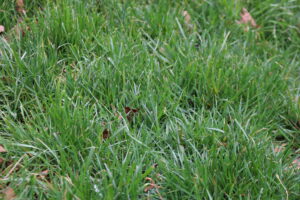Fall Is the Time for Tall Fescue Lawn Maintenance
go.ncsu.edu/readext?1093981
en Español / em Português
El inglés es el idioma de control de esta página. En la medida en que haya algún conflicto entre la traducción al inglés y la traducción, el inglés prevalece.
Al hacer clic en el enlace de traducción se activa un servicio de traducción gratuito para convertir la página al español. Al igual que con cualquier traducción por Internet, la conversión no es sensible al contexto y puede que no traduzca el texto en su significado original. NC State Extension no garantiza la exactitud del texto traducido. Por favor, tenga en cuenta que algunas aplicaciones y/o servicios pueden no funcionar como se espera cuando se traducen.
Português
Inglês é o idioma de controle desta página. Na medida que haja algum conflito entre o texto original em Inglês e a tradução, o Inglês prevalece.
Ao clicar no link de tradução, um serviço gratuito de tradução será ativado para converter a página para o Português. Como em qualquer tradução pela internet, a conversão não é sensivel ao contexto e pode não ocorrer a tradução para o significado orginal. O serviço de Extensão da Carolina do Norte (NC State Extension) não garante a exatidão do texto traduzido. Por favor, observe que algumas funções ou serviços podem não funcionar como esperado após a tradução.
English
English is the controlling language of this page. To the extent there is any conflict between the English text and the translation, English controls.
Clicking on the translation link activates a free translation service to convert the page to Spanish. As with any Internet translation, the conversion is not context-sensitive and may not translate the text to its original meaning. NC State Extension does not guarantee the accuracy of the translated text. Please note that some applications and/or services may not function as expected when translated.
Collapse ▲Tall fescue is a cool-season turfgrass. During the fall as temperatures cool, tall fescue plants break dormancy and begin actively growing again. This makes the fall a great time for renovation, seeding, and maintenance of tall fescue lawns.
Tall fescue is a clumping grass and is easy to establish from seed. Over time, a tall fescue lawn will become patchy and may require overseeding. The best time for seeding depends on the weather, with optimum temperatures for tall fescue germination occurring when air temperature is between 68 to 77°F, and soil temperatures are above 60°F. The NC State Climate Office provides data from weather stations to help you determine soil and air temperature. Click here to view data from the station at the NC A&T State University Research Farm in Greensboro – this data reflects nearby conditions for Forsyth County residents. In general, September through mid-October is a good time to seed tall fescue. Check out this article for details specific to seeding your tall fescue lawn in the fall.
When selecting seed for yards in Forsyth County, look for a seed blend that contains multiple cultivars of tall fescue. Check the 2022 top performing tall fescue cultivars for a guide. Typically, the cultivars of fescue contained in the seed blend are listed on the bag, often on the back of the bag.
Fall is also a great time to perform other lawn maintenance while your tall fescue lawn is actively growing. You may need to aerate a tall fescue lawn, which can help with soil compaction. It is also a good time to fertilize. Be sure to take a soil test to determine the best type of fertilizer for your yard. For more details on lawn maintenance, check the tall fescue lawn maintenance calendar or Carolina Lawns.

Core aerification removes clay cores from the soil surface and helps with compaction problems in lawns.
If you have a warm-season lawn such as bermudagrass or zoysiagrass, your lawn is going dormant at this time of the year. It is normal for the lawn to turn a brown color while it is dormant in the winter. You want to wait to perform maintenance on these lawns until the weather warms again next spring and summer. The bermudagrass lawn maintenance calendar and the zoysiagrass lawn maintenance calendar are helpful guides for managing warm-season lawns.





